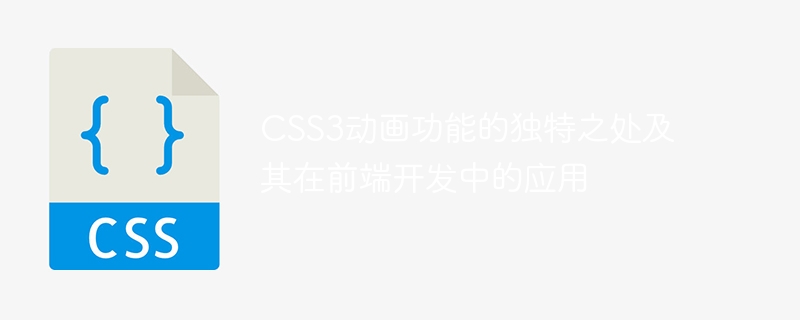

The unique features of CSS3 animation function and its application in front-end development
In front-end development, the animation function of CSS3 is a very important technology. Compared with traditional JavaScript animation, CSS3 animation has unique advantages. This article will introduce the unique features of CSS3 animation function and give some specific usage examples.
CSS3 animation uses CSS styles to control the animation effects of elements. Compared with traditional JavaScript animation, CSS3 animation has the following unique advantages.
First of all, CSS3 animation is based on browser hardware acceleration. In modern browsers, CSS3 animations can be rendered using hardware acceleration, so they have a huge advantage in performance. In contrast, traditional JavaScript animation is based on browser software rendering, and its performance is worse.
Secondly, CSS3 animation does not require writing complex JavaScript code. Traditional JavaScript animation usually requires writing complex logic code to control the animation effect of elements. CSS3 animation only requires a few lines of CSS styles to achieve the same effect. This greatly simplifies the development workload.
In addition, CSS3 animation has better maintainability. Since CSS3 animations are based on CSS styles, they can be separated from other styles, making the code clearer and easier to maintain. Traditional JavaScript animation requires mixing animation logic with HTML and CSS, which is not easy to separate and maintain.
Next, let’s look at some specific examples of CSS3 animations.
First, we can define an animation sequence through the @keyframes rule of CSS3. The example below is a simple animation that moves an element from left to right:
@keyframes moveRight {
from {
transform: translateX(0);
}
to {
transform: translateX(100px);
}
}
.box {
width: 100px;
height: 100px;
background-color: red;
animation: moveRight 1s linear infinite;
}In the above example, we first defined an animation sequence named "moveRight" using the @keyframes rule. In this animation sequence, we set two keyframes, which are the initial state and the end state of the element, and achieve the translation effect of the element by setting the transform attribute. Then, in the .box style, we apply the animation sequence to the .box element through the animation attribute, which specifies the duration, playback method, and number of loops of the animation.
In addition to translation effects, CSS3 animations can also achieve more complex effects. For example, we can achieve the rotation, scaling, and tilting effects of elements by setting the transform attribute; achieve the fade-in and fade-out effects of elements by setting the opacity attribute; achieve the color gradient effect of elements by setting the background-color attribute, and so on.
In addition, CSS3 animation also supports some common animation functions to achieve more vivid and natural animation effects. For example, we can use the ease-in function to achieve the transition effect of elements being slow first and then fast; use the ease-out function to achieve the transition effect of elements being fast first and then slow; use the ease-in-out function to realize the transition effect of elements being slow first and then fast. No matter how slow the transition effect is, etc.
In short, the CSS3 animation function has unique advantages, including performance advantages, simplicity and ease of use, and good maintainability. In front-end development, we can make full use of CSS3 animation to achieve various animation effects and bring a better browsing experience to users.
Here is a brief introduction to some basic concepts and application examples of CSS3 animation. I hope it will be helpful to readers. In actual development, there are many more complex and advanced technologies and applications that require further learning and practice.
The above is the detailed content of The unique features of CSS3 animation function and its application in front-end development. For more information, please follow other related articles on the PHP Chinese website!
 Skills required for front-end development
Skills required for front-end development
 The function of net user command
The function of net user command
 Solutions to unknown software exception exceptions in computer applications
Solutions to unknown software exception exceptions in computer applications
 How to set font color in html
How to set font color in html
 What skills are needed to work in the PHP industry?
What skills are needed to work in the PHP industry?
 How the temperature sensor works
How the temperature sensor works
 The difference between footnotes and endnotes
The difference between footnotes and endnotes
 Is Huawei's Hongmeng OS Android?
Is Huawei's Hongmeng OS Android?